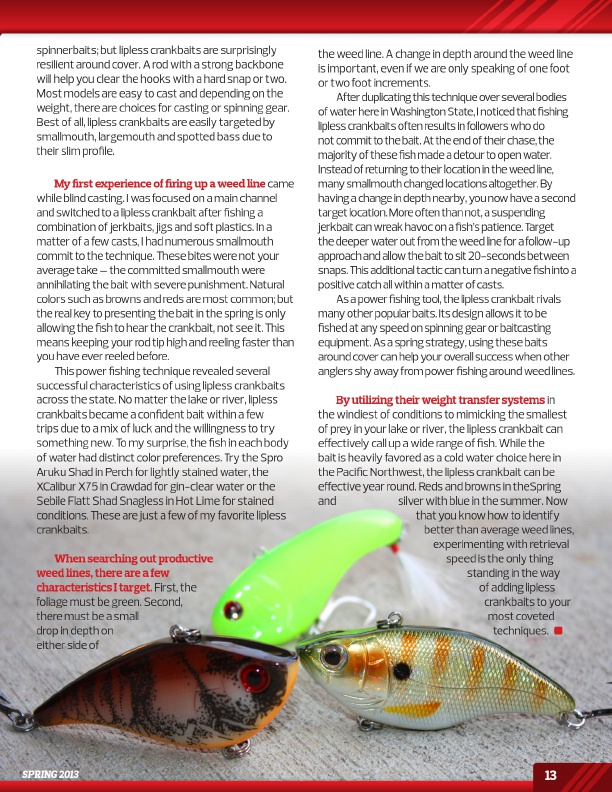
spinnerbaits; but lipless crankbaits are surprisingly resilient around cover. a rod with a strong backbone will help you clear the hooks with a hard snap or two. Most models are easy to cast and depending on the weight, there are choices for casting or spinning gear. Best of all, lipless crankbaits are easily targeted by smallmouth, largemouth and spotted bass due to their slim profile.
My first experience of firing up a weed line came while blind casting. i was focused on a main channel and switched to a lipless crankbait after fishing a combination of jerkbaits, jigs and soft plastics. in a matter of a few casts, i had numerous smallmouth commit to the technique. These bites were not your average take – the committed smallmouth were annihilating the bait with severe punishment. Natural colors such as browns and reds are most common; but the real key to presenting the bait in the spring is only allowing the fish to hear the crankbait, not see it. This means keeping your rod tip high and reeling faster than you have ever reeled before. This power fishing technique revealed several successful characteristics of using lipless crankbaits across the state. No matter the lake or river, lipless crankbaits became a confident bait within a few trips due to a mix of luck and the willingness to try something new. to my surprise, the fish in each body of water had distinct color preferences. try the Spro aruku Shad in Perch for lightly stained water, the XCalibur X75 in Crawdad for gin-clear water or the Sebile Flatt Shad Snagless in Hot lime for stained conditions. These are just a few of my favorite lipless crankbaits.
When searching out productive weed lines, there are a few characteristics I target. First, the foliage must be green. Second, there must be a small drop in depth on either side of
the weed line. a change in depth around the weed line is important, even if we are only speaking of one foot or two foot increments. after duplicating this technique over several bodies of water here in Washington State, i noticed that fishing lipless crankbaits often results in followers who do not commit to the bait. at the end of their chase, the majority of these fish made a detour to open water. instead of returning to their location in the weed line, many smallmouth changed locations altogether. By having a change in depth nearby, you now have a second target location. More often than not, a suspending jerkbait can wreak havoc on a fish’s patience. target the deeper water out from the weed line for a follow-up approach and allow the bait to sit 20-seconds between snaps. This additional tactic can turn a negative fish into a positive catch all within a matter of casts. as a power fishing tool, the lipless crankbait rivals many other popular baits. its design allows it to be fished at any speed on spinning gear or baitcasting equipment. as a spring strategy, using these baits around cover can help your overall success when other anglers shy away from power fishing around weed lines.
By utilizing their weight transfer systems in the windiest of conditions to mimicking the smallest of prey in your lake or river, the lipless crankbait can effectively call up a wide range of fish. While the bait is heavily favored as a cold water choice here in the Pacific Northwest, the lipless crankbait can be effective year round. reds and browns in theSpring and silver with blue in the summer. Now that you know how to identify better than average weed lines, experimenting with retrieval speed is the only thing standing in the way of adding lipless crankbaits to your most coveted techniques.
spring 2013
13